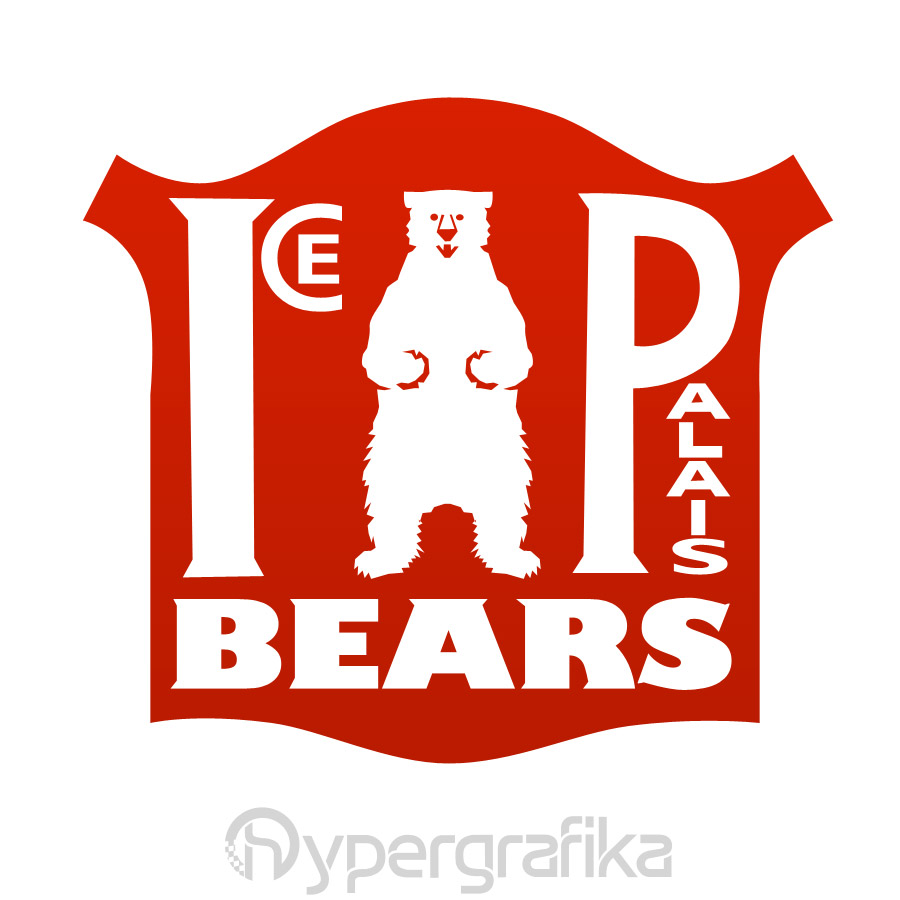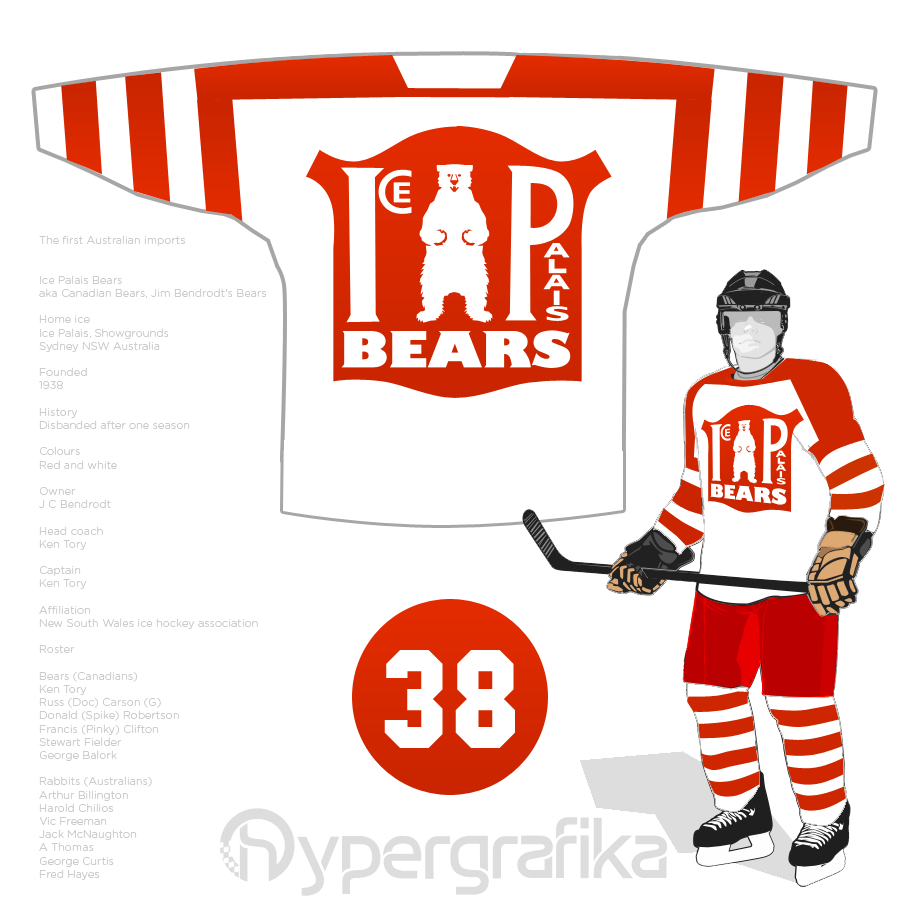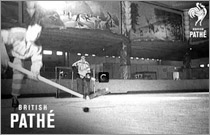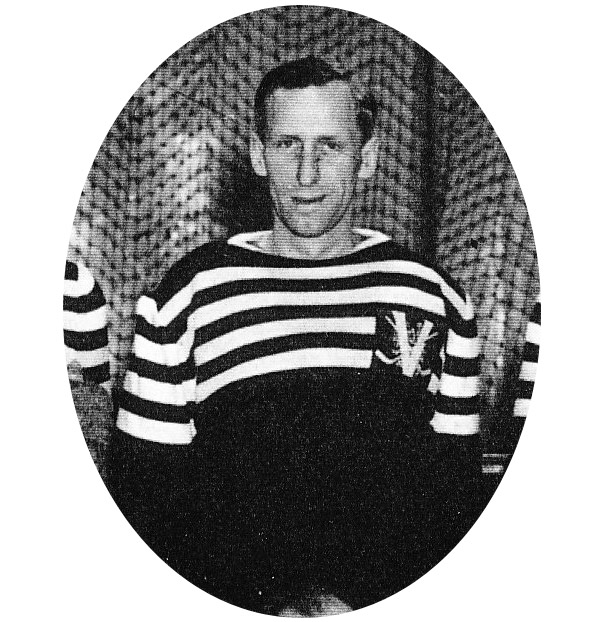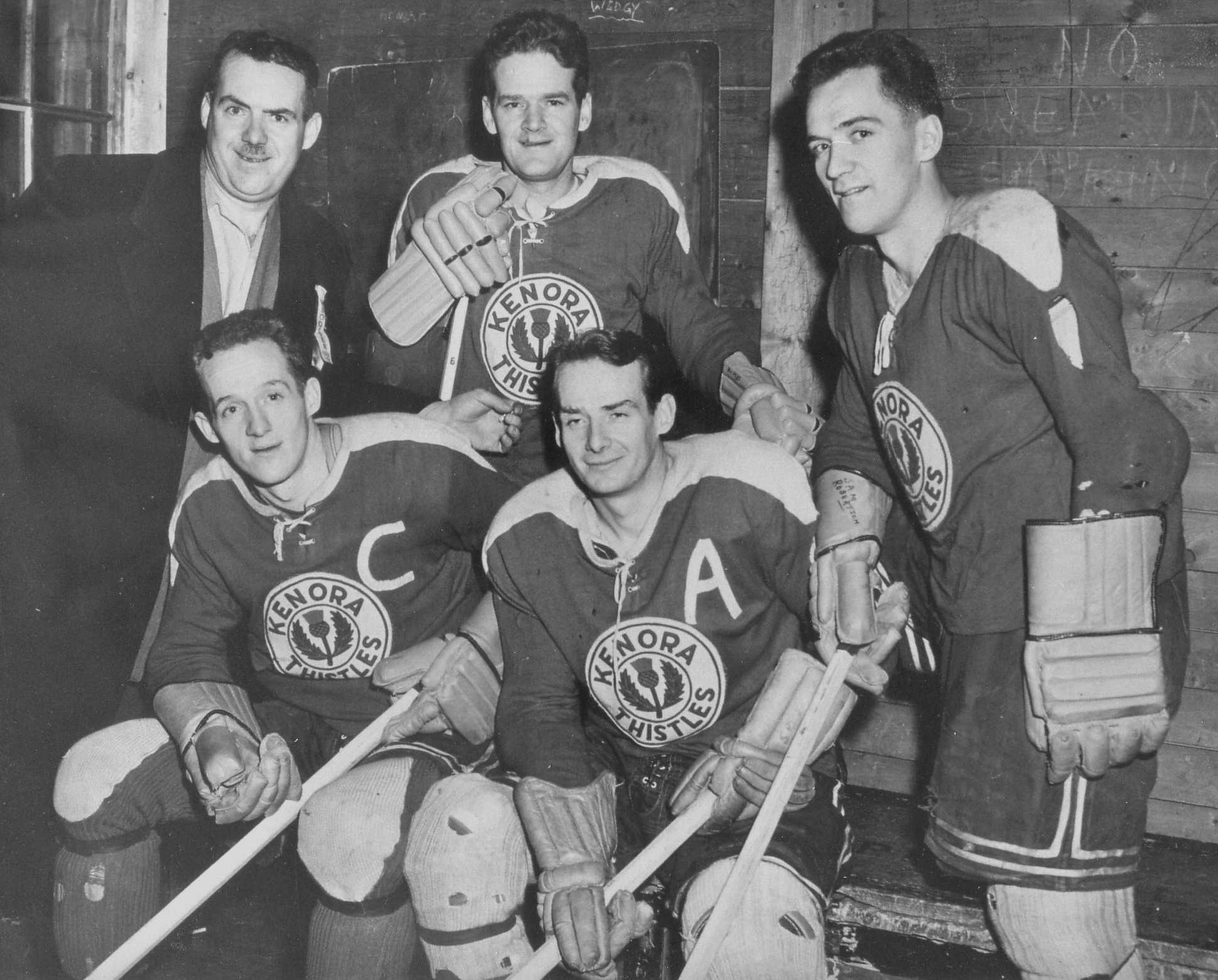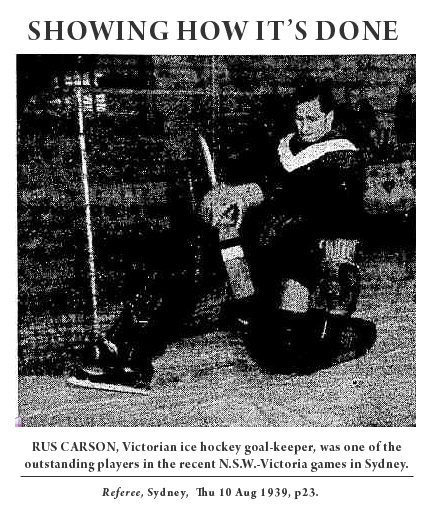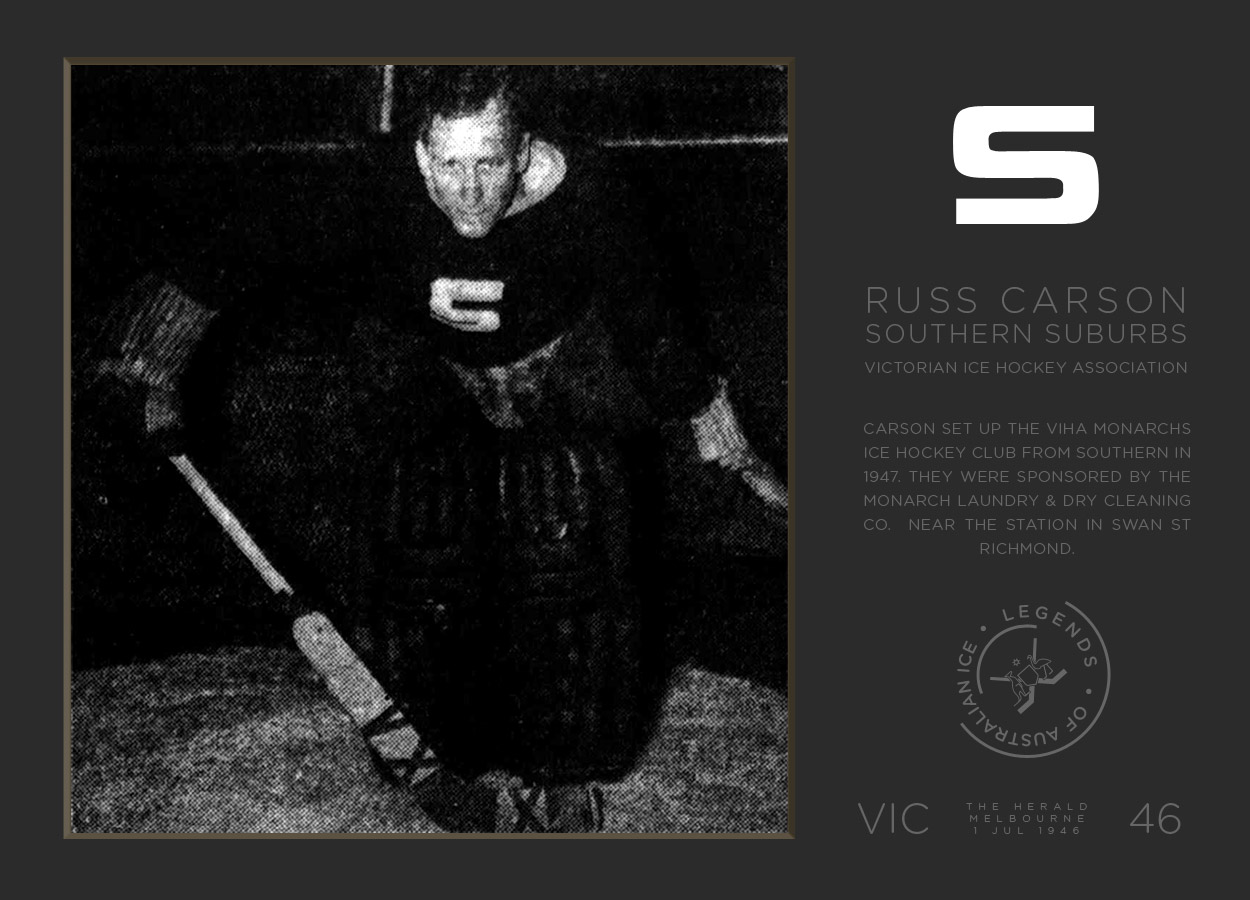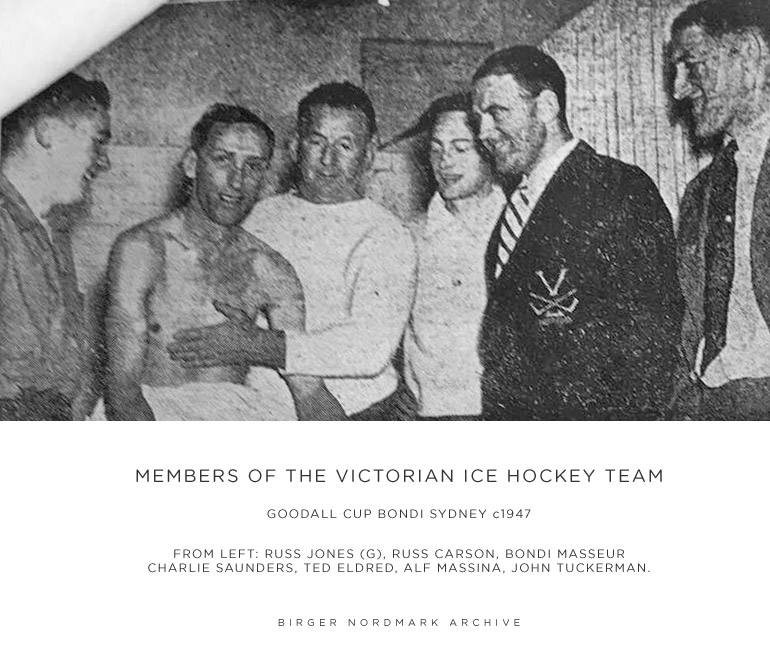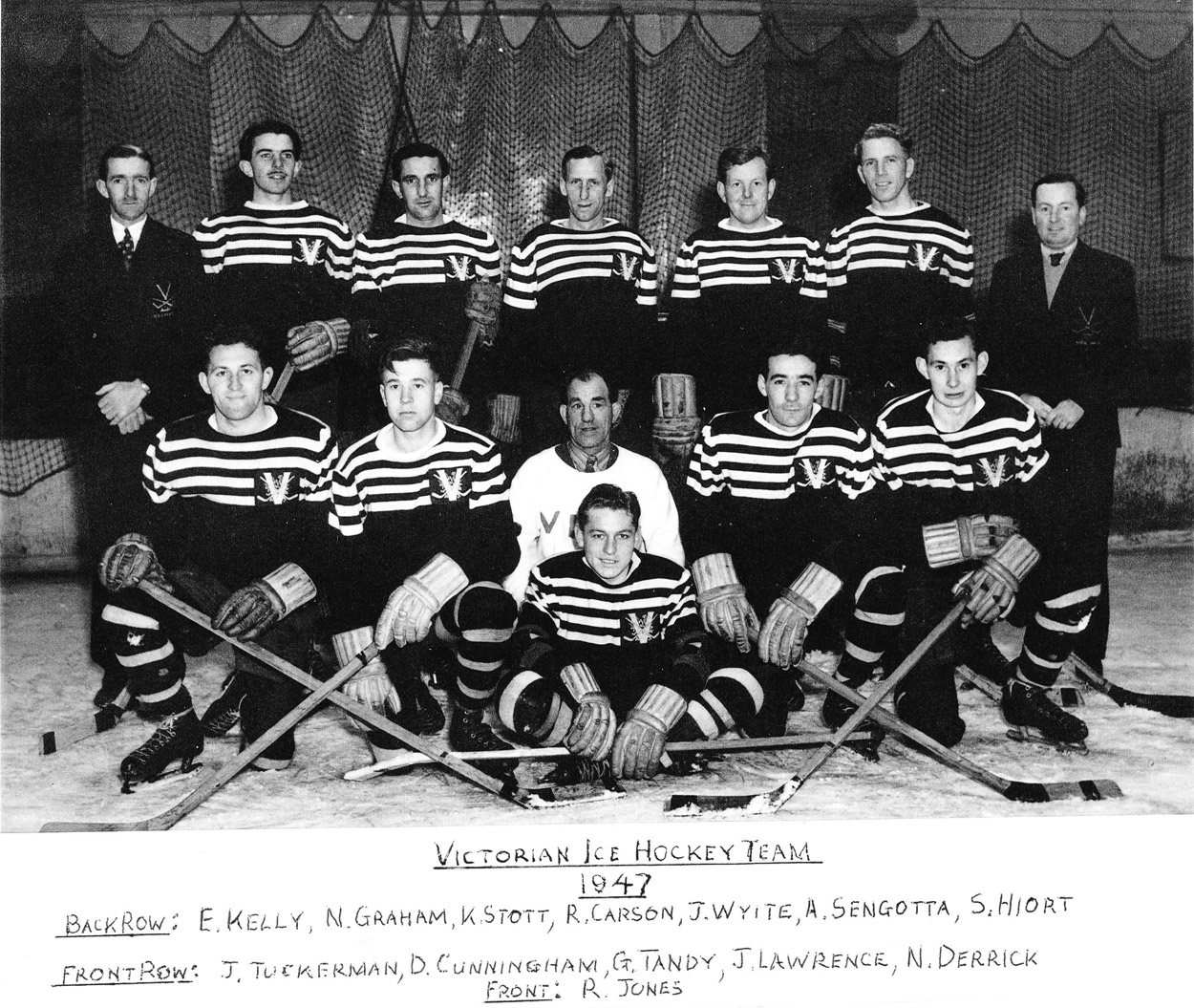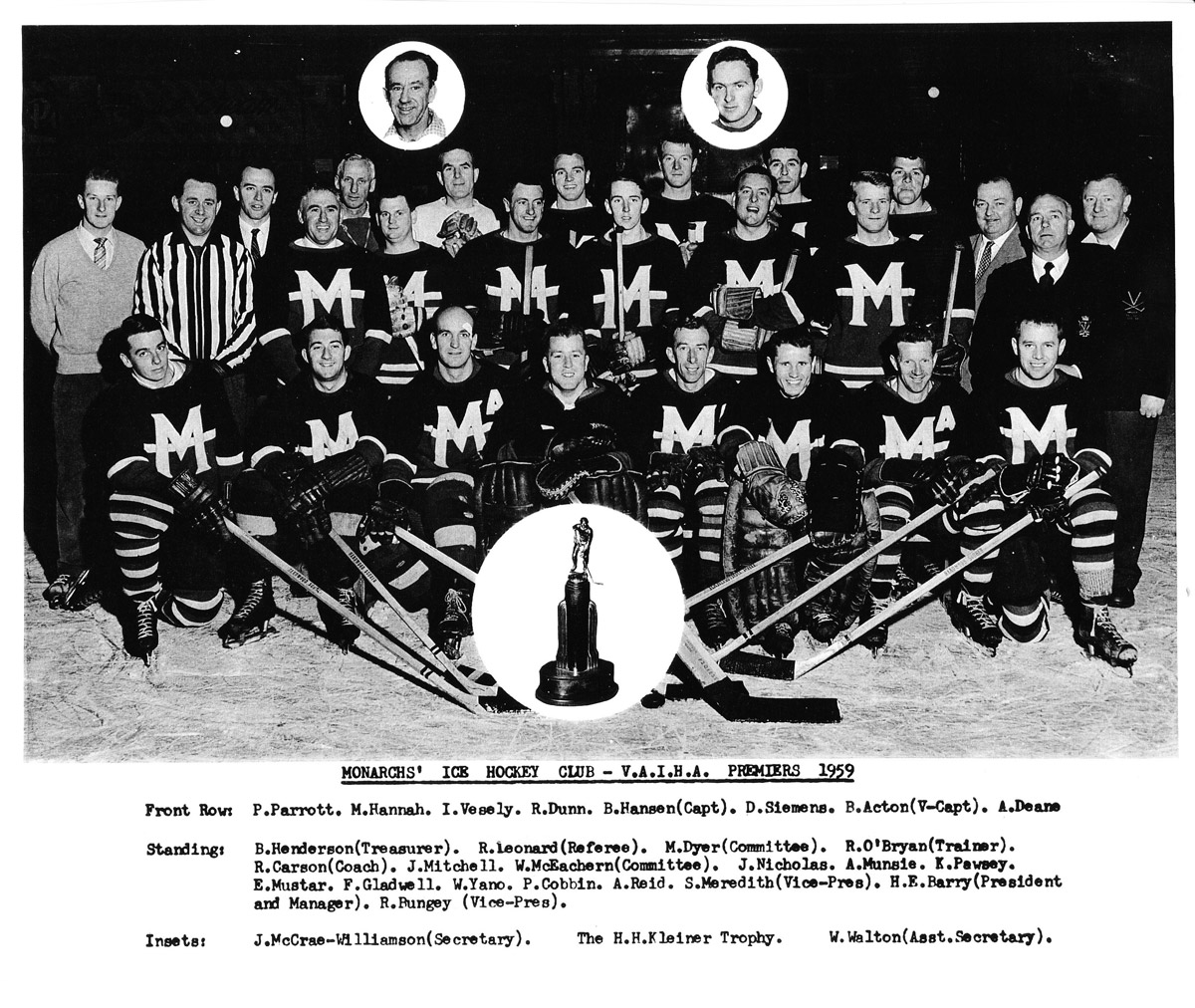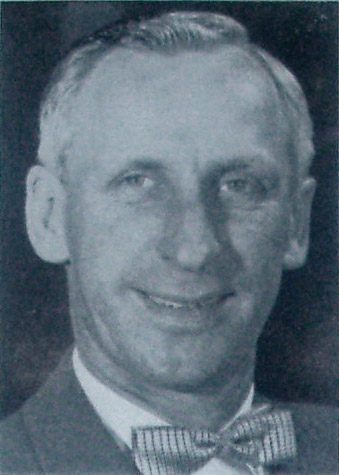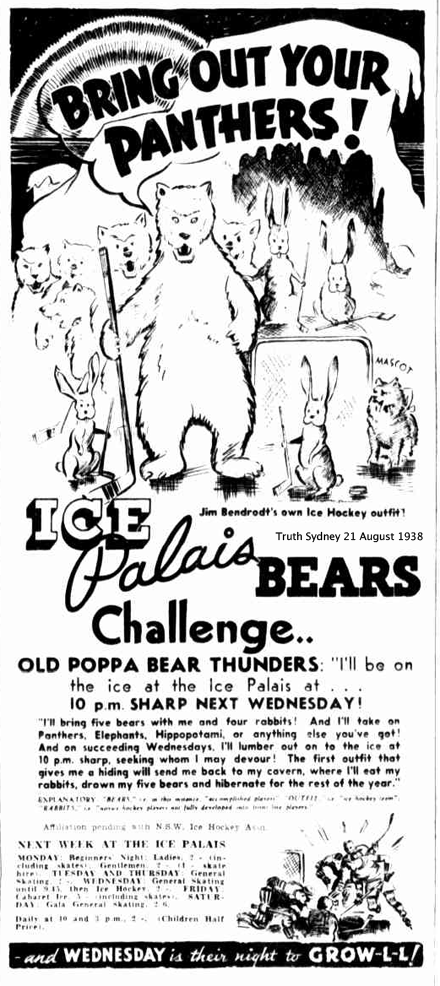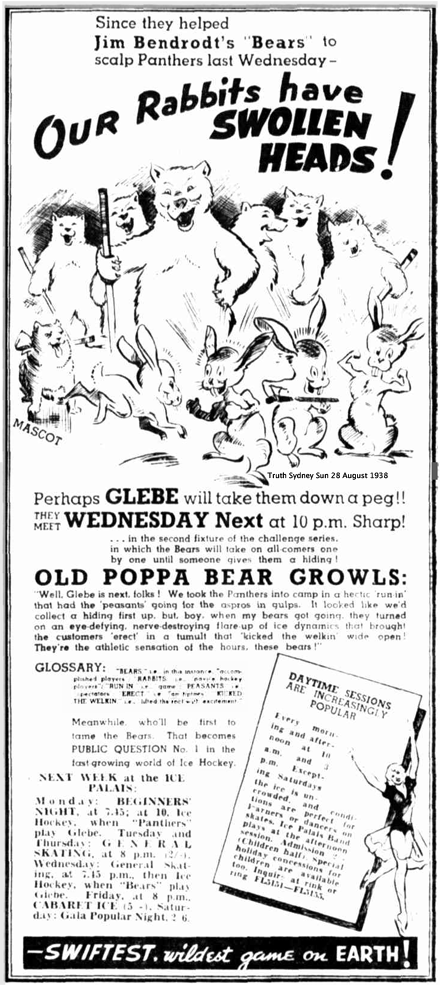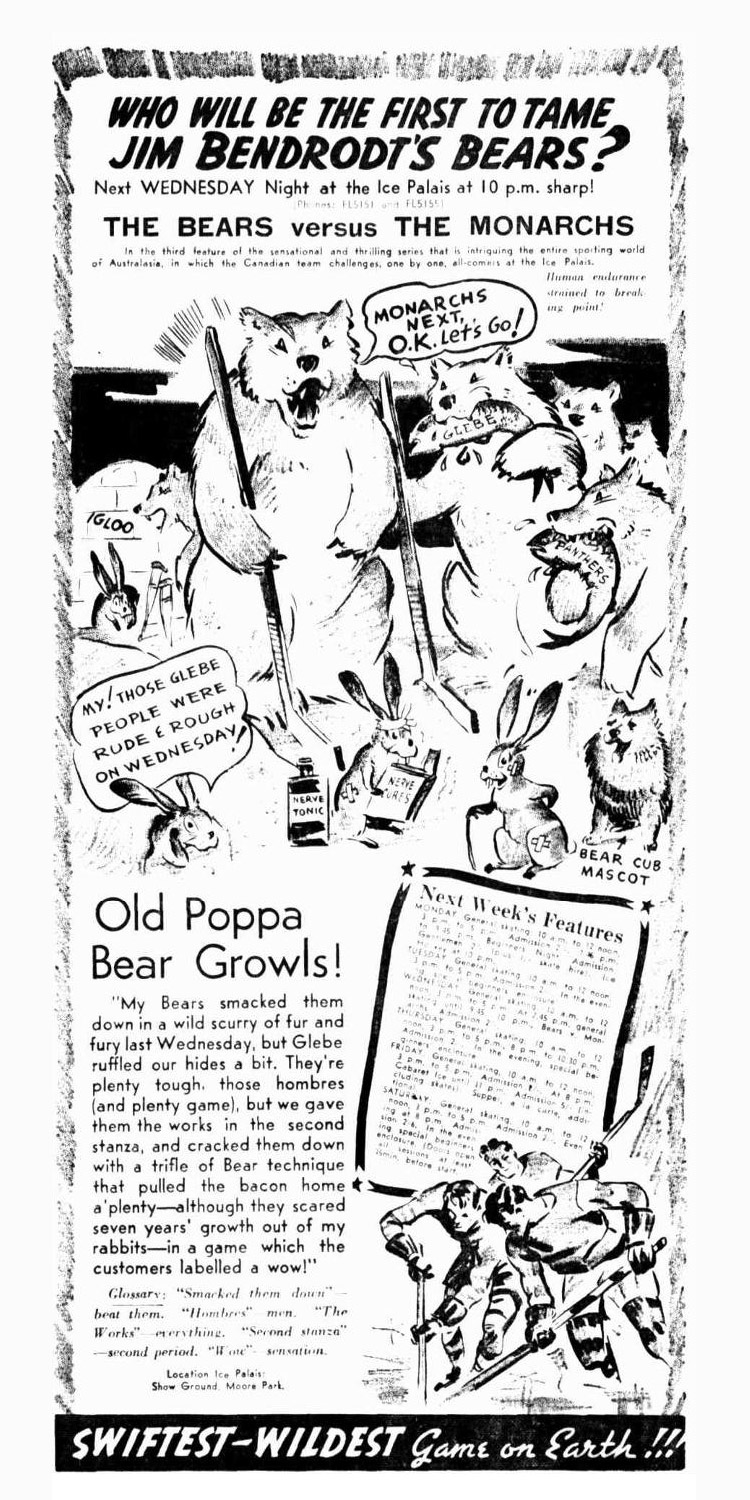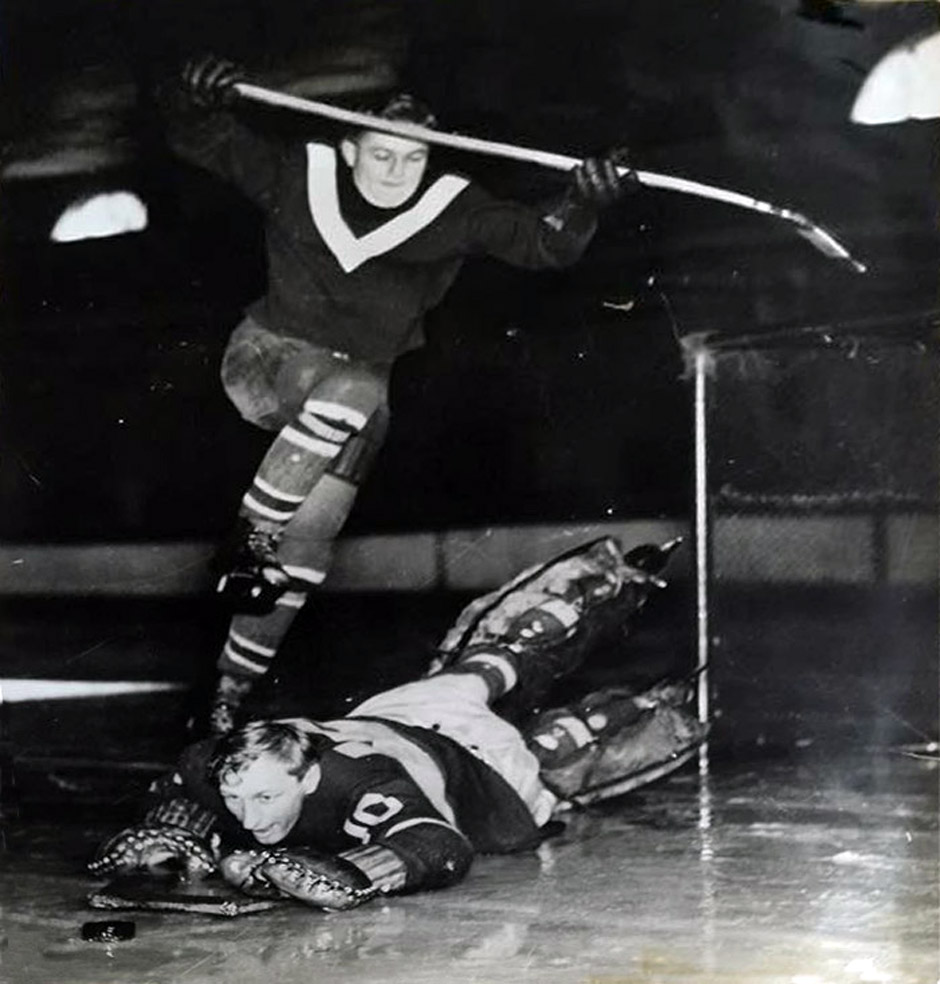
RUSS CARSON IN NET WITH THE YOUNG RUS JONES, STATE TRAINING, MELBOURNE, AUSTRALIA, c1948. [8]

Ad — Bears vs NSW Allstars
Daily Telegraph, Sydney, 25 Sep 1938. 3-game series against players of the breakaway Australian Ice Hockey Amateur Association. Bears won, 4-3, 6-6, 9-4.
Widdy Johnson (C), Percy Wendt, Bede Moller, Norm McMillan (G), Noel Payne, Jim Kennedy, Jack Ridgeway, Ray Lincoln, Noel Dunnett, Syd Hudson. [2]

Ad — Canada vs Australia
The Sun, Sydney, 14 Oct 1938, played Oct 15, 19, 22. Canada won 4-1, 5-4, 8-3. Bears billed as Canada, Australia unofficially represented by members of the breakaway Association and 3 top Victorian players. Canada won 4-1, 5-4, 8-3. [2]
Norm Macmillan (G), Bede Moller, Widdy Johnson, Percy Wendt, Noel Payne, Chris Mitchell, with Victorians Hugh "Spot" Lloyd, Ellis Kelly, Johnny Whyte.
Talkie
Russ Carson and the road less travelled
![]() I move that the Australian Ice Hockey and Speed Skating Council set up a committee to raise funds for the sending of a team to the 1948 Olympic Games.
— Russ Carson, Victorian delegate to the national ice hockey association, 1946. [2]
I move that the Australian Ice Hockey and Speed Skating Council set up a committee to raise funds for the sending of a team to the 1948 Olympic Games.
— Russ Carson, Victorian delegate to the national ice hockey association, 1946. [2]
 Ice Palais Bears aka Canadian Bears, Bendrodt's Bears. Ice Palais, Moore Park, Sydney, 1938. The jerseys were scarlet and white, Canada's national colours. Courtesy Wendy Ovenden and Syd Tange.
Ice Palais Bears aka Canadian Bears, Bendrodt's Bears. Ice Palais, Moore Park, Sydney, 1938. The jerseys were scarlet and white, Canada's national colours. Courtesy Wendy Ovenden and Syd Tange.
From left: Russ (Doc) Carson, Arthur Billington, Francis (Pinky) Clifton, Harold Chilios, Vic Freeman, Jack McNaughton, Stewart Fielder, George Balork, Donald (Spike) Robertson, Ken Tory. Corrected from the original in "Facts and Events", Syd Tange, 1999.
[2]
THE POPULAR YOUNG CANADIAN who appeared at breakfast with the pocket of the Kenora Thistles on his blazer was twenty and already well-known to the patrons of the Palais Royale Ice Skating Rink in Sydney. Otherwise, the guests of the Hydro Majestic Hotel in the Blue Mountains would never have known who he was. Kenora in the north-west of Canada was tiny, the smallest community to ever win a Stanley Cup.
The Hydro Majestic, Australia's first health retreat, had its share of celebrities over the years, including Sherlock Holmes' creator Sir Arthur Conan Doyle. Famous Australian Opera singer, Dame Nellie Melba sang there, as did English Opera singer Dame Clara Butt and Nellie Stewart. "Spike" Robertson was one of the Canadian Bears brought to Sydney in 1938 by Jim Brendrodt to show young Australians “how to attain that certain something that goes to make the ideal ice hockey player”.
Donald Archie Robertson was born December 22nd 1918 in Ignace, Ontario, one of six sons of Fanny and Peter Robertson. [20, 23] He could skate at the age of four years, taught by Fanny and Peter at Laurenson’s Creek in Kenora or at Central Rink. The family moved to Kenora leaving behind the "one room schoolhouse" to attend Central Public School. On the corner of First and Ninth, the brothers thrived playing horse puckey and hockey at Central Rink. [20]
Spike excelled at gridiron football at college and was also good at softball and baseball. However, ice hockey was his long suit, and so it was he came to captain the Kenora Thistles in the Manitoba Junior Hockey League. The Thistles were once runners-up to Winnipeg Monarchs in the South Division at Winnipeg. After Technical College, Spike planned to do medicine, but decided on exhibition ice-skating and seeing the world. Affable and unassuming, he was very popular in Sydney, but moved on to the Northern Hockey League in New York State before returning home to the Thistles. In 1952-3 his club won the Western Canadian Intermediate Championship and toured Japan. [3]
Jimmy Bendrodt planned the opening of his new Ice Palais skating rink to coincide with Sydney's sesqui-centenary celebrations in 1938, which included hosting the Commonwealth Games. [1] The local ice hockey association wanted to take part in the Games, and entered negotiations with Victoria, Canada and Britain. But the talks broke down when Canada asked for one pound per day per player for out-of-pocket expenses. Leo Molloy at the Melbourne rink pulled out, leaving the Sydney rinks unable to afford it.
For the first time in Australia, the ice hockey premiership season was held at two rinks. The big ice, 61 by 30m, made games seem slower and not so exciting compared to the smaller Glaci. The promise of more Sydney ice time did raise expectations of a brighter future, but as Syd Tange reflected many years later "who could foretell what lay ahead?" [2]
Jim Prentiss, a young Kenora swimmer representing Canada at the Sydney Games, contacted a young goalkeeper in the local team back home, the Kenora Thistles. Goalie Russ Carson saw the opportunity for a team to go to Australia and play for the Ice Palais. He contacted Bendrodt who sponsored four Kenora players to visit in August 1938 — Francis "Pinky" Clifton, Stewart Fielder, Robertson and Carson. Fielder and Clifton were the first line of the Kenora Clayton's Flyers, Northwestern Canada's Allan Cup finalists the previous winter.
Bendrodt filled out the line-up with two Canadians already in Sydney, George Barlork (West Panthers) and Ken Tory (East Monarchs), who took on all three roles of captain, coach and manager. Four young "rabbits" from local clubs gave the imports a breather if required. The local association accepted the team's application for affiliation.
Despite the public controversy, the violence, the suspensions, and the resulting breakaway association, the Bears did encourage young locals to try ice hockey — players such as Phil Ginsberg and Geoff Thorne. A wisp of a lad, Thorne became friendly with Spike, who taught the young Australian every trick of the game every Sunday on the ice, until eventually he became a second Spike.
He had the same red hair, the same control of the puck as the brilliant Canadian, and he skated in the same style, swinging on one leg with the same body sway. "All I know is due to Spike," said Thorne, "He spent hours with me and I am deeply grateful for everything he showed me". The Kenora boys were good people. The support the state received from the Canadian association prompted Australia to apply for IIHF affiliation. It was granted within the year, but it would take another 22 for the nation to reach the world stage.
Encouraged by his literary godfather, Frank Clune, Bendrodt published a short story in 1946 based on the most controversial ice hockey game of the season, Bears' v St George. Spike appears in his first collection, A man a dog two horses, the tale of the superb Canadian ice hockey champion fighting against overpowering odds to win the game for "The Boss".
When Sydney ice hockey arrived at a crossroads in 1938, the Ice Palais Bears were its defining moment. Carson took the road less travelled to Victoria and the Olympic Dreams of the 1960s. The ghosts of Bendrodt's Bears and Rabbits still shape the New South Wales game.
COUNTLESS REPORTS of strange occurrences in the Hockey Hall of Fame Toronto over fifty years connect to a ghost known only as "Dorothy". Lights flickering on and off, doors and windows opening and closing for no good reason, moans, screams and other eerie sounds echoing through the historic former Bank of Montreal. Staff members hear footsteps when working alone at night. A few have felt a phantom hand on their shoulder or leg. One or two have even seen Dorothy.
"Haunted by the past," we say, usually about people who need therapy. But the habit of no acknowledgment is woven so deeply into a century of sporting culture here — on the foggy ice and in the makeshift board rooms — it would be no surprise if bodily fear and spiritual anguish could adhere to a place. Because haunted is precisely what we are. Not the ectoplasmic kind. We just don't like to face much about our pasts. The national culture of discussion of local ice sports is opaque, clouded by euphemism, denial, and hope.
With war imminent, Bendrodt's conversion of his Sydney dance hall into the new Ice Palais in 1938 might have raised an eyebrow, but the announcement of his second ice skating rink directly opposite Melbourne Glaciarium was like a red flag to a bull.
Late that year, Russ Carson made his way south from Sydney for the Melbourne Cup, the race that stops a nation. Shown over Streets of Paris, a dance hall run by Harry Kleiner, Carson remarked it would make a great ice rink. Some months later, a letter informed him the dance hall had been converted to an ice rink, just as Bendrodt had done in Sydney the year before. [2] The Sydney promoter did not build his Melbourne rink. The last three surviving clubs in Melbourne had disbanded due to the war, when Kleiner invited Carson to organise an ice hockey competition on St Kilda's fabled Esplanade.
Talkie or Doc, as he was known, moved to Melbourne where he formed the St Moritz Bombers ice hockey club at the dawn of Victoria's first inter-rink era. It was not Association hockey, rather a power struggle between two competing ice rinks. Fred Palmer, Trade Commissioner for Canada, coached the Bombers and Canadian expat, Hugh Lloyd, coached the Rangers at the rival rink. Players and spectators in Sydney had quickly become accustomed to Talkie's high-pitched Canadian drawl during play, but it spread like wildfire through the Flyers and Topliners in Carson's reserve-grade house league during the war.
Crowds of 3,500 attended Bombers versus Rangers games in 1939, with pre-game match entertainment by World Champion skater, Megan Taylor, among others. Carson's teammate George Balork joined him on the St Moritz payroll, raising questions over their amateur status, since both continued to play. The Bombers were almost unbeaten for their first two seasons.
An offer to join the Golden Gate Dairy ice hockey club of the Industrial League of California was postponed and then rejected. The goalie with the inimitable style, both minding net and chatting to teammates and spectators, made Melbourne his home instead.
"What do you think of the standard of ice hockey in New South Wales?" a reporter once asked after Bendrodt's Bears scored 22 goals to 5 in their first three games against local teams. And Carson replied: "Australia should send a team to the Olympic Games in 1940. It would not beat Canada, USA or Great Britain, but it would beat all of the European teams". [7] Bendrodt had entertained, if not inspired New South Wales hockey in 1938, but it was this simple Q & A that came to define their southern rival.
"Australia is a long way below international standards," countered Ken Tory, the Bears' captain and coach. There is too much individualism and not enough teamwork in Australia. It would cost £500 to bring a leading overseas coach to Australia for a season, but the result would be worth it". [7]
Upset by the comment, Jim Brown hit back in the same tabloid. "Canada, Great Britain and Germany would probably be too strong for Australia," he said. "But countries such as Sweden, Norway, Poland, France, etc are not above the Australian standards". [7] Brown played for Great Britain against teams from Germany, France (HC Chamonix), and Switzerland (EHC St Moritz and HC Davos).
Even visiting Hockey Hall-of-Famer, Hap Holmes, said Australia's ice hockey standard was very high. "It compares with industrial ice hockey in the USA," he said, "one of the teams from which competition won the world's championship some time back". Tom Coulter, the brother of Art Coulter who captained the New York Rangers, said he was very surprised at how good Australian ice hockey was. [7] Tom had played two NHL games for Chicago.
Like Carson, Jim Brown believed there was every chance of Australia sending a team to the next Olympic Games in St Moritz Switzerland, if a move was made early. Years later, Claud Hamil shared the same sentiment after coaching New South Wales to the 1952 Goodall Cup. "Although not up to the standard of Canada, Sweden or America," said the former coach of Belgium, "Australia compares well with the Continental Countries. I would rate the 1952 Victorian forward line of Rus Jones, Al Sengotta and David Cunningham equal to any in Europe." In fact, every one of these hockey internationals believed that Australia could compete at Olympic level, providing it imported expert coaching. Then war intervened.
"A plan for Australia's participation in the 1948 Olympic Games," announced Russ Carson when peace came. The small gathering shifted a little in their chairs while the Victorian delegate to the national association addressed the 1947 Annual Meeting. Jack Paton, who had returned to office at war's end, chaired the meeting. [2] Harold Waddell Hoban returned as leader of the state association. In a strange twist, his state secretary, Syd Hiort, had just succeeded Ted Molony as president of the Victorian association. After a long absence, John Goodall, the first national president of ice hockey in 1923, returned to the Victorian association as junior vice-president. [10]
Born January 30th 1915 in Kenora, Canada, [15, 16] to John and his Scottish wife, Agnes, Carson grew up in the 2-storey weatherboard house at 621 Second Street, [13] in the little town with less than 6,000 residents. His home was a short walk from Laurenson’s Creek where Spike Robertson learned to skate. At 23, Carson left his parents and sisters Dorothy and Marion for Sydney. Five years later, he married June Lesley Marks in Melbourne, [12] and enlisted in the Australian Army. He rose to the rank of Captain in New Guinea, in the fight to liberate what was then Australian territory. [16]
"The team should leave Australia in time to spend a few weeks in Canada before arriving in England," Carson continued his briefing. "So that they can practice in charge of a leading coach. Harry Neil of Winnipeg, who managed and coached several Canadian championship teams, would be an ideal choice".
Neil had earned a reputation in the US as one of the sharpest judges of the game by coaching teams such as the Winnipeg Navy Club against the New York Rangers. The Navy were led by Hughie Millar who later earned a brief spell with the Detroit Red Wings. [5]
"I suggest a team of fifteen ice hockey players, four speed skaters, and a manager. [3] The speed skaters are close to world-class, so they too should receive expert coaching a fortnight ahead of the Games".
The national association was not completely convinced — a lot of organisation and cooperation would be necessary to raise the money — but its members appointed a committee to go ahead. [4] Neither association in Melbourne or Sydney had ever contributed towards the expenses of their players when they made interstate trips. The rinks promoting interstate games provided a subsidy, but the balance came out of the player's own pocket, and it was usually a lot. [6] Not surprisingly then, the committee could not raise enough money. The number of raffles, barbecues and movie nights were limited by the short time available. But, for the first time, they had a go.
Before moving to Australia, Carson made Allan Cup elimination games in the Manitoba-Thunder Bay district. [14] In 1936-7, he played with the Kenora Clayton's Flyers in the Kenora Commercial League, then the Toronto Posties in 1937-8, the year his home team made the Manitoba Senior Playoffs. They lost 3-1 to Red Lake Thunderers who advanced to the Western Canada Allan Cup Playoffs, only to lose in the semi-final. [18] Carson knew hockey. Back then, he was considered the best goaltender to play in Australia.
"If Canada had grabbed these youngsters as kids", he said "they would have been world beaters. Cunningham, who is speedy, and times his shots at goal judiciously, is the better of the two at present. But, in a year or two, Jones might easily be the star". Victoria's Dave Cunningham and Rus Jones first played for the Goodall Cup in 1946 when Carson minded net.
Carson coached and played in Southern Suburbs that year, then formed the Monarchs from it in 1947–8, Victoria's most successful ice hockey club of all time. Later, he recruited Elgin Luke as playing coach of the club. [25] In a playing career rudely interrupted by war, he represented Victoria in the Goodall Cup in 1939, '46 and the historic '47 team that won it back for the first time in a quarter century. "We hit Carson with everything," said Jim McLauchlain after the first match. "He was too tough". [21] Carson was 32 in this last of his three series for the state. [1] It was a turning point in Victoria's fortunes.
But it was the Olympics that so inspired Talkie — the amateur game — and long before the all-time boom years of Victorian hockey in the Fifties. It's well worth noting the sixty players affiliated with the pre-war association, grew to 180 in April 1947, [24] before crowds of 4,000 or more.
Carson romanced the Olympic dream, perhaps because of his remote, small-town beginnings. By the 1930s, pro hockey teams and leagues were a "North American reality", but pro teams were not viable in the northwest, and might never be. [9] There were just too many others with more money and more concentrated populations who also loved the game.
A distaste for professionalism had been present in the district long before Carson was born, due in part to the niggling problem at the core of pro sport — the athletes were usually imports, and this destroyed the "representative" qualities of the competition. [18]
But by the time Carson played amateur hockey in the north-west, most locals considered the game a legitimate means of earning money for those who had developed their talents to a very high level. [9] Carson may not have reached that level at home, but he was able to orchestrate something good for himself on the other side of the globe, through the ice rink operators in Melbourne and Sydney, the first new ones since the Australian game had begun.
In 1955, the national association led by Ken Kennedy asked Carson to be the fund raiser for the proposed ice hockey team to compete at the 1956 Games in Italy. [2] It took until 1960 to introduce Australian ice hockey to the world, and it might not have happened even then, but for Britain's scheming Bunny Aherne at the top of the IIHF. [22] Even so, it was Carson who navigated the machinations of the sport's great and not-so-great administrators, along the boulevard of broken dreams, in the back alleys of broken promises.
Appointed general manager of Australia's first Olympic ice hockey team in California, Carson continued in the role with the World Championship teams of the early Sixties. The second Worlds team in Colorado recorded Australia's historic first International win, and Carson was effectively coach and manager of the Olympic playoffs team against Japan in Tokyo in 1963-4. Awarded the HC and SM Hudson Trophy in 1965, for ten years continuous service to the Australian game, his contribution was in reality a lot longer than that.
One of the few people active in all three of Australia's first international ice hockey campaigns, Carson continued as secretary-treasurer of the national association until 1975, [2] and delegate to the State Olympic Council until 1969. He also held a long association with water polo, serving as vice-president of both the Victorian Amateur Water Polo Association and the Melbourne Collegians Water Polo Club based at the St Kilda Sea Baths. His Olympic ice hockey colleagues, Peter Parrott and John Nicholas, were also club members.
Carson's other official roles included VIHA delegate to the Victorian Olympic Council (1968–9), vice-president of Melbourne Collegians Water Polo Club (1957–76), MCWPC Victorian delegate to the Australian Olympic Federation (1960–69), vice-president of the Victorian Amateur Water Polo Association (1958–61), and manager of the Victorian Amateur Water Polo Association 1959 state team. [19]
Russ Carson died in Melbourne at 81 on October 14th 1996, survived by his wife June and son, Peter. He was a Life Member of his state and national ice hockey associations.
[1] The Empire Games during the week 5–12 February 1938 were timed to coincide with Sydney's sesqui-centenary (150 years since the foundation of British settlement in Australia)
[2] Ice Hockey: the NSW Ice Hockey Association Inc Australia — Facts and Events 1907-1999, Syd Tange, IHNSW, 1999. Courtesy Wendy Ovenden.
[3] Donald "Spike" Robertson played for the Thistles each season from 1935-6 until 1937–8, but went missing from their rosters from 1938–9 when he was recruited for the Ice Palais Bears in Australia. So too did Clifton and Fielder on and off, but Fielder never returned. Robertson played Wing for Hibbing Saints in the Northern Hockey League (NorHL, New York State), returning to Kenora Thistles in 1949.
[4] Ice hockey team for Olympics? Sporting Globe Melbourne Aug 3 1946
[5] Winnipeg Free Press – Tuesday 27 October 1942
[6] Ice hockey visit, The Herald Melbourne 19 Jul 1947
[7] Australia's ranking in ice hockey, controversy started by Canadian's criticism. Referee, Sydney, 8 Sep 1938.
[8] Hockey Colts Impressive, The Daily Telegraph Sydney 14 Sep 1946
[9] An Immense Hold in the Public Estimation: The First Quarter Century of Hockey in Manitoba, 1886-1911. Morris Mott, Brandon University, Manitoba History magazine, Number 43, Spring / Summer 2002, Manitoba Historical Society. Online
[10] Office bearers of the Victorian Ice Hockey Association, Paul Rice, Melbourne, 7 June 2016.
[11] In 1938, Ted Molony, treasurer of the Victorian association, was appointed president, with his son in law, Alf Massina as secretary. He attempted to align his Glaciarium in Melbourne with the Ice Palais in Sydney.
[12] Births Deaths and Marriages, Victoria Department of Justice, Reg No 16403.
[13] Sixth Census of Canada, 1921, Ontario province. Carson was 6. His father (43) was an engineer of Irish origin and his mother (34) immigrated in 1888 from Scotland. He had 2 sisters, Dorothy 15, and Marian, 2.
[14] Birger Nordmark, IIHF historian, Sweden.
[15] Springvale Botanical Cemetery, Russell William Carson.
[16] World War II Nominal Roll, Commonwealth of Australia, 2002. Carson enlisted at Caulfield on August 25th 1942. He was discharged from 3 Advanced Ordnance Depot on 17 May 1946.
[17] Email, Birger Nordmark, 12 Dec 2014.
[18] The Problems of Professionalism: The Manitoba Amateur Athletic Association and the Fight Against Pro Hockey 1904-1911, Morris Mott in E. A. Corbet and A. W. Rasporich (eds.), Winter Sports in the West (Calgary: Historical Society of Alberta and University of Calgary, 1990), pp. 135-136.
[19] Melbourne Collegians Water Polo Club Inc. A History, 1894 - 1994, incorporating Melbourne Swimming Club and Old Wesley Collegians Water Polo Club, compiled by Russell S. Fletcher, Club Member 1978-1994, unpublished.
[20] Legends Facebook, 2017. Jim Robertson wrote: there were 6 Robertson brothers, Gordie is not in picture. He along with my dad "Pete" (John A. ) were not hockey players. There was also a 7th brother, George, who was the eldest and was killed by a train in Ignace when he as 9. Pete, was the third eldest and he was born in Medicine Hat, Alberta. The family then moved to Ignace, Ontario then to Kenora, I am guessing they learned to skate on Laurenson’s Creek in Kenora or at Central Rink according to Sugar’s wife.
[21] Seven off in ice hockey, The Daily Telegraph, Sydney, 30 Jul 1947, p 28.
[22] Ahearne held both Carson's and Tange's proxy votes at the IIHF Congress at the 1962 Worlds in Colorado Springs, even though they were both there. Swedish National Archive, Rudolf Eklow and Swedish Ice Hockey Association collections.
[23] People of Kenora website, Joyce Blythe.
[24] Never grow old, The Herald, Melbourne, 15 Apr 1947 p 12.
[25] Elgin Luke, Legends Facebook, October 2018.

